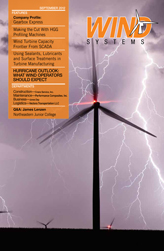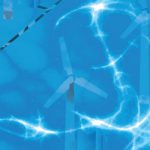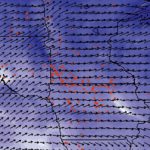The world has seen a significant expansion of renewable energy generation over the last decade. Wind energy has become the greatest contributor to this growth. The wind turbine generated energy depends on the wind potential and the turbine availability impacted by faults and repairs. Faults are responsible for reduction of the overall capacity of wind turbines. Supervisory control and data acquisition (SCADA) systems record wind turbine parameters, which can be used to monitor their performance. Successful applications of SCADA data usage include: power optimization [1], power curve monitoring [2], and fault diagnostics and prognostics [3].
Data envelopment analysis (DEA) is an analytical technique to assess capacity factor of wind turbines. DEA has been successfully applied in healthcare, marketing, and manufacturing. However, the application of DEA in wind energy is new. Assessment of turbine capacity in presence of faults is performed using SCADA data and fault logs. The results of this analysis are useful in prioritizing maintenance operations.
Turbine Capacity and Data Envelopment Analysis
The capacity of a wind turbine can be measured by its power producing capability in a given operational time period. Of two turbines operating for a certain fixed time, a turbine producing more power is considered to be more efficient. Apart from the wind speed, downtime caused by turbine faults and power curtailment leads to power generation losses. In simple terms, the capacity factor of a wind turbine is expressed as the ratio of actual power generated by a wind turbine over the maximum power that could be produced. The capacity of a wind turbine can be affected by factors such as repair and maintenance downtime and external downtime (power curtailment), and fault downtime. Analysis of the impact of the faults on the capacity of wind turbines is imperative.
Data Envelopment Analysis Single Input-Single Output
Data envelopment analysis is a powerful technique for the assessment of relative capacity of wind turbines [4]. The analysis presented in this article is based on data (Jan 2006 – Dec 2008) from 10 wind turbines, each 1.5 MW. The cut-in, cut-out, and the rated wind speed were 3.5m/s, 25 m/s, and 12 m/s, whereas, the rotor speed ranged from 0-23 rpm. Figure 1 illustrates the performance of wind turbines by DEA. Clearly, turbine 1, turbine 5, and turbine 8 are efficient and thus makes the capacity frontier, whereas, turbine 4, turbine 6, and turbine 10 are inefficient. DEA assesses relative capacity of wind turbines. Turbines with relative capacity score of 1 are considered to be efficient, whereas turbines with relative capacity less than 1 are inefficient.
Multiple Input-Single Output
To gain more insights into turbine performance, operational time, maintenance and repair downtime, external downtime (power curtailment), and fault downtime are considered. An input oriented data envelopment analysis approach is used to assess the turbine capacity under different downtime scenarios. Figure 2a, Figure 2b, Figure 2c, Figure 2d illustrate the capacity of 10 wind turbines for different downtime scenarios. The results provided in Figure 2 (a)-(d) are summarized in Table 1. Based on the analysis, the capacity degradation is higher in scenarios considering fault downtime (Figure 2c), and external downtime (Figure 2d). Turbine 8 found to be the efficient in all scenarios. While the downtime due to scheduled repair and maintenance, and power curtailment cannot be avoided, analyzing the fault information is useful in improving capacity factors of wind turbines.
Even though the turbines analyzed here are from the same original equipment manufacturer (OEM), certain replacement components such as generators, brush type, and bearings might possess different characteristics.Figure 3b – Figure 3a For example, the ABB generators installed in certain wind turbines may have poorer performance (due to overheating issues) than the Hitachi generators. Thus, the inefficient turbines identified here can be made efficient by closely following the components of efficient turbines.
Multiple Input-Single Output With Fault Information
A typical wind turbine issues many status codes. Wind turbines statuses can be a system update only (turbine curtailment, turbine idling) or fault informative (blade pitch fault, generator fault). The fault informative statuses triggering more than the specified limit may cause the turbine to shut down or run sub-optimally, resulting in poor capacity factor. Figure 4 represents such fault informative statuses observed from 10 different wind turbines over a period of three years. Table 1
The Figure 5 graph presents the turbine capacity under different fault scenarios. The analysis is done on the data combined from 10 wind turbines. Based on the results, turbines without any statues is the ideal condition, however, while just fixing the critical statuses (as mentioned in Figure 4); the efficiency can be improved to a greater extent. Among faults, fixing the blade pitch faults and timely performing the battery test can improve the turbine capacity. Generators, gearbox related faults do not differ much from the original (real) capacity due to their less frequent observations in the data. While the relative capacity score under different fault scenario does not seem to be differing, it has bigger implications in terms of overall production loss (Figure 6). Based on the historical data, turbines on average produce 39000 KWh of energy per month. Thus, in one year, by fixing certain faults, the overall yield can be improved.
Conclusions
The downtime related with power curtailment and faults are the main factors responsible for turbine inefficiency. The analysis performed here clearly indicates the role of data envelopment analysis approach in wind turbine capacity evaluation. The approach is particularly useful in prioritizing maintenance tasks. In the event of several concurrent faults in a wind farm, faults causing the most degradation in turbine capacity should be fixed first.








































